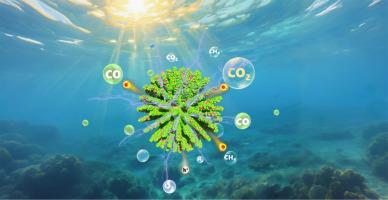类海胆S-Scheme异质结的构建:三维CoNiO2/W18O49复合材料用于高效CO2光还原的案例研究
IF 14.3
1区 材料科学
Q1 MATERIALS SCIENCE, MULTIDISCIPLINARY
引用次数: 0
摘要
二氧化碳光还原(CO2 PR)技术被广泛认为是缓解能源短缺危机的一种有前途的方法。在多种策略中,提高载流子分离效率和拓宽光谱响应范围是推进CO2 PR发展的有效手段。本研究采用两步水热法合成了一种新型S-scheme异质结CoNiO2/W18O49复合催化剂。利用其异质结构和增强的可见光吸收能力,该复合材料表现出了更高的载流子分离效率和卓越的CO2分子捕获能力,从而实现了卓越的CO2 PR性能。优化后的CW-3样品CO和CH4的析出率分别为87.17和92.42 μmol g−1 h−1,分别是原始CoNiO2的6倍和33倍。结合理论计算和系统表征,最终论证了s型异质结界面本征电场的形成机理。复合材料通过优化能带对准增强了可见光吸收,同时通过协同界面电荷转移和能带弯曲效应显著提高了载流子分离效率。这种集成增强机制源于异质结构中CoNiO2和W18O49组分之间的互补电子相互作用。本文章由计算机程序翻译,如有差异,请以英文原文为准。

Construction of a sea-urchin liked S-Scheme heterojunction: A case study using 3D CoNiO2/W18O49 composite for efficient CO2 photoreduction
The CO2 photoreduction (CO2 PR) technique is widely acknowledged as a promising approach to mitigating energy shortage crises. Among various strategies, enhancing the efficiency of charge carrier separation and broadening the spectral response range are effective means to advance the development of CO2 PR. In this study, a novel S-scheme heterojunction CoNiO2/W18O49 composite catalyst was synthesized through a two-step hydrothermal method. By leveraging its heterostructure and enhanced visible-light absorption capacity, the composite demonstrates improved carrier separation efficiency and superior CO2 molecule capture capability, thereby achieving exceptional CO2 PR performance. The optimized CW-3 sample exhibited remarkable CO and CH4 evolution rates of 87.17 and 92.42 μmol g−1 h−1, respectively, representing 6-fold and 33-fold enhancements compared to pristine CoNiO2. Combined theoretical calculations and systematic characterizations conclusively demonstrated the formation mechanism of the intrinsic electric field at the S-scheme heterojunction interface. The composite material simultaneously enhanced visible-light absorption through optimized band alignment and significantly improved charge carrier separation efficiency driven by synergistic interfacial charge transfer and band bending effects. This integrated enhancement mechanism stemmed from the complementary electronic interactions between CoNiO2 and W18O49 components within the heterostructure architecture.
求助全文
通过发布文献求助,成功后即可免费获取论文全文。
去求助
来源期刊

Journal of Materials Science & Technology
工程技术-材料科学:综合
CiteScore
20.00
自引率
11.00%
发文量
995
审稿时长
13 days
期刊介绍:
Journal of Materials Science & Technology strives to promote global collaboration in the field of materials science and technology. It primarily publishes original research papers, invited review articles, letters, research notes, and summaries of scientific achievements. The journal covers a wide range of materials science and technology topics, including metallic materials, inorganic nonmetallic materials, and composite materials.
 求助内容:
求助内容: 应助结果提醒方式:
应助结果提醒方式:


